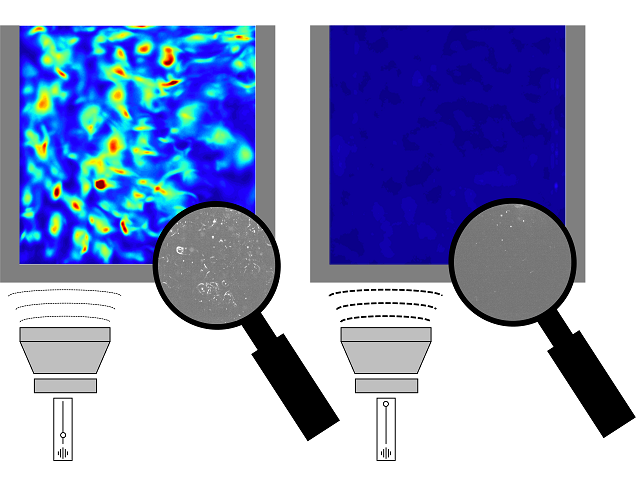Research News
Jul 8, 2025
- Engineering
For ultrasound, ultra-strength not always a good thing
New study explains why too much ultrasound slows chemical reactions
Ultrasonic irradiation and bubble formation
Changes in reaction velocity distribution in a vessel at different ultrasonic output levels, and magnified images of bubble generation.
Credit: Osaka Metropolitan University

Osaka Metropolitan University researchers have solved a long-standing mystery in the field of sonochemistry: why do chemical reactions slow down when ultrasonic power becomes too strong? Their findings allow for smarter use of ultrasound in science and industry, such as for environmental cleanup or the creation of useful nanoparticles.
Although ultrasound is inaudible to the human ear, it plays a powerful role in sonochemistry. When ultrasonic waves are applied to a liquid, they generate microscopic bubbles that rapidly expand and collapse, a process called acoustic cavitation. The collapse produces bursts of energy that momentarily reach temperatures comparable to the surface of the sun, triggering chemical reactions.
“Typically, increasing ultrasonic output speeds up the reaction,” said Takuya Yamamoto, associate professor at Osaka Metropolitan University’s Graduate School of Engineering and lead author of this study. “But once the output exceeds a certain level, the reaction rate rapidly drops. That paradox has puzzled researchers for years.”
This counterintuitive phenomenon is also one of the key challenges in developing practical industrial uses for ultrasound.
To uncover the mechanism behind this “ultrasonic reversal,” the team conducted six types of experiments, including bubble imaging, sonochemiluminescence observations, and sound pressure measurements, along three types of numerical simulations that modeled bubble behavior and internal temperatures.
Their findings revealed that when ultrasonic power becomes too strong, the intense movement of bubbles distorts the ultrasonic waves. This distortion suppresses bubble growth and drastically reduces the number of active bubbles capable of driving chemical reactions — ultimately slowing the overall reaction rate.
The researchers also identified three distinct regions of ultrasonic reactions, each characterized by different wave patterns and bubble dynamics. These insights help explain how chemical reaction rates, bubble growth, acoustic streaming, and degassing behavior all change depending on the intensity of the ultrasound.
“Our study helps demystify a complex phenomenon during which sound waves, fluid motion, and bubble physics are all interacting,” Yamamoto said.
Understanding this balance is key to making sonochemistry more predictable and scalable for real-world use.
“We hope this result will open the door to broader industrial applications of ultrasonic technology, from synthesizing nanoparticles to breaking down persistent pollutants like PFAS, the so-called ‘forever chemicals’,” Yamamoto said.
The study was published in Ultrasonics Sonochemistry.
Funding
JST, PRESTO Grant Number JPMJPR22OA, Japan
Paper information
Journal: Ultrasonics Sonochemistry
Title: Revisit to the mechanism of quenching: Power effects for sonochemical reactions
DOI: 10.1016/j.ultsonch.2025.107419
Authors: Ryota Aoki, Kanji D. Hattori, Takuya Yamamoto
Published: 6 June 2025
URL: https://doi.org/10.1016/j.ultsonch.2025.107419
Contact
Takuya Yamamoto
*Please change [at] to @.
SDGs
